View in other NatureServe Network Field Guides
NatureServe
Montana
Utah
Wyoming
Idaho
Wisconsin
British Columbia
South Carolina
Yukon
California
New York
Sulphur Cinquefoil - Potentilla recta
Other Names:
Sulfur Cinquefoil
State Rank Reason (see State Rank above)
Potentilla recta is a plant native to the eastern Mediterranean region and introduced into North America (Rice in Sheley and Petroff 1999). A conservation status rank is not applicable (SNA) because the plant is an exotic (non-native) in Montana that is not a suitable target for conservation activities.
NOTE: There is a discrepancy between the number of observations and counties represented in the herbaria (Consortium of Pacific Northwest Herbaria; www.pnwherbaria.org) versus the Montana Natural Heritage Program databases. It is important to document new County and other site occurrences with nice quality plant specimens of which some should be deposited in our State herbaria (University of Montana, Montana State University, Montana State University-Billings). Depositing specimens in the herbaria allows identifications to be confirmed, provides a central location for educating and sharing information, and allows specimens to be studied for genetics, morphology, and ecology.
General Description
PLANTS: Perennial forb that grows from a simple to branched caudex. Stems are singular to several, erect, and 20-50 cm tall. Stems have hispid hairs – long, straight, stiff, and perpendicular to the stem. Plants grow from a taproot with some shallow, spreading roots. Source: Rice in Sheley and Petroff 1999; Lesica et al. 2012
LEAVES: Leaves are arranged alternately. In outline leaf blades are somewhat round and 2-7 cm long. Leaves are palmately divided into 5 to 7 lanceolate, dentate leaflets with spreading hairs. Leaf size decreases upwards on stem. Petioles have hispid hairs which are perpendicular to the stalk. Basal leaves are similar. Source: Lesica et al. 2012
INFLORESCENCE: Yellow flowers are arranged in an open, flat-topped cyme (above the height of the leaves). 5 green sepals are lanceolate in shape, strongly veined, and 4–7 mm long. Bracteoles alternate with and appear similar to the sepals. 5 petals are light (sulphur) yellow, 6–10 mm long, longer than the sepals, and notched. Source: Lesica et al. 2012
Phenology
Flowers in late spring through summer (Ertter and Reveal in FNA 2014).
Diagnostic Characteristics
Montana has at least 30
Potentilla or Cinquefoil species (Lesica et al. 2012). Readers are encouraged to learn their identifiable traits before implementing control on an unrecognized plant!
Sulphur Cinquefoil –
Potentilla recta, exotic and Noxious:
* Fewer basal leaves with numerous stem leaves.
* Plants with long hairs perpendicular to their surface.
* Inflorescence ‘flat-topped’ and bright, light-yellow flowers.
* Taproot has short branches.
* Plants are more yellowish-green in comparison to other Potentilla plants.
* Leaflets are serrated about half-way to their mid-veins.
* Seeds with a net-like pattern on their coat.
Fanleaf Cinquefoil –
Potentilla gracilis, native and desirable:
* Many basal leaves and relatively fewer stem leaves.
* Plants with short, spreading hairs.
* Underside of leaves have dense, woolly hairs.
* Plants are rhizomatous.
* Flowers are brighter/darker yellow.
* Leaves are green to gray-green.
* Leaflets are serrated more than half-way to their mid-veins.
* Seeds have a smooth coat.
Species Range
Montana Range
Range Descriptions
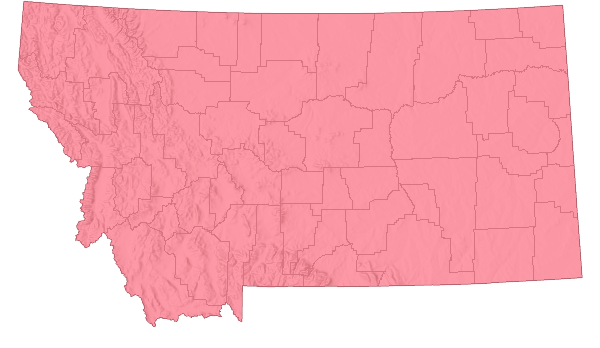
 Non-native
Non-native
Range Comments
Sulphur Cinquefoil is native to the eastern Mediterranean region of Eurasia (Rice in Sheley and Petroff 1999). It was first documented in North America as a weed from a garden in Montreal, Canada in 1852 (Ertter and Reveal in FNA 2014). By 1900 it was fairly wide spread in the New England states, and by the 1950s it was established in Canada, the Great Lakes Region, and Northeastern U.S. (Ertter and Reveal in FNA 2014). In 1915 it was documented in British Columbia, Canada (Consortium of Pacific Northwest Herbaria (CPWNH); posted as of February 5, 2019 at www.pnwherbaria.org). By the 1930’s it was documented in Washington and Idaho (CPWNH; posted as of February 5, 2019 at www.pnwherbaria.org).
In Montana herbarium specimens document its presence in Mineral County in 1955, Powell County in 1956, and Ravalli County in 1959 (CPNWH; posted as of February 5, 2019 at www.pnwherbaria.org).
Adhikari et al. (2020) modeled the predicted future distribution of this and other weed species across the major road network in Montana under predicted future climate scenarios and found that area of predicted future habitat suitability is likely to increase.
For maps and other distributional information on non-native species see:
Nonindigenous Aquatic Species Database from the U.S. Geological Survey
Invasive Species Habitat Tool (INHABIT) from the U.S. Geological Survey
Invasive Species Compendium from the Centre for Agriculture and Bioscience International (CABI)
EDDMapS Species Information EDDMapS Species Information
Observations in Montana Natural Heritage Program Database
Number of Observations: 12974
(Click on the following maps and charts to see full sized version)
Map Help and Descriptions
Relative Density
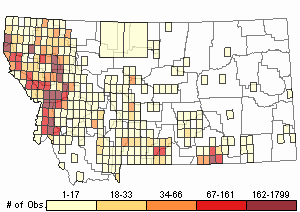
Recency
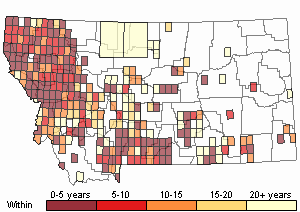
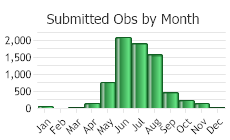
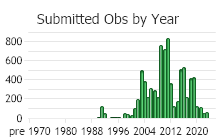
 (Observations spanning multiple months or years are excluded from time charts)
(Observations spanning multiple months or years are excluded from time charts)
Habitat
Grasslands, meadows, pastures, and disturbed forests in the plains, valleys, and montane zones of Montana (Lesica et al. 2012).
Ecology
VULNERABLE HABITATS [Adapted from Rice
in Sheley and Petroff 1999]
Sulphur Cinquefoil has a wide ecological amplitude. In Montana it has been found in conifer, grassland, shrubland, and seasonal wetland systems. It has been found on most soil types; although not in pure silt. Sulphur Cinquefoil can colonize native plant communities without any apparent human disturbance. It has been found to get a hold into healthy, native grasslands by colonizing the ephemeral streams where soil is naturally disturbed (Andrea Pipp, MTNHP Botanist, personal observation).
DOMESTIC GRAZINGSulphur Cinquefoil is primarily avoided by domestic animals. A study found that Sulphur Cinquefoil had trace-utilization on many sites used by livestock while Spotted Knapweed (Centaurea stoebe) had a 30% utilization.
POLLINATORS The following animal species have been reported as pollinators of this plant species or its genus where their geographic ranges overlap:
Bombus bifarius,
Bombus fervidus,
Bombus frigidus,
Bombus rufocinctus,
Bombus occidentalis,
Bombus pensylvanicus,
Bombus impatiens, and
Bombus flavidus (Thorp et al. 1983, Wilson et al. 2010, Colla and Dumesh 2010, Colla et al. 2011, Koch and Strange 2012, Koch et al. 2012, Williams et al. 2014).
Reproductive Characteristics
Plants reproduce by seed.
FRUITS
Fruits are achenes, ridged with thickened margins and about 1 mm long. Seeds are small, shaped like a comma (“,”), flattened, brownish-purple, and covered with a net-like pattern of veins (Rice in Sheley and Petroff 1999).
LIFE CYCLE [Adapted from Rice in Sheley and Petroff 1999]
Plants emerge in early spring. In Montana plants can produce basal leaves beginning in early March. Basal rosettes are fully formed in April. Plants often bolt in May and by June are blooming. With sufficient moisture flowering can occur into autumn. Seeds mature in July and disperse in August. Leaves senesce in August, but basal leaves can ‘green-up’ in response to late summer or early autumn rains. Growth continues until an extended freeze occurs.
Seeds remain viable in the soil for at least 3 years.
Management
An integrated vegetative management approach provides the best long-term control, and requires that land-use objectives and a desired plant community be identified (Shelly et al.
in Sheley and Petroff 1999). Once identified an integrated weed management strategy can be developed to promote a weed-resistant plant community and that serves other land-use objectives such as livestock forage, wildlife habitat, or recreation.
PREVENTION [Adapted from Rice
in Sheley and Petroff 1999]
Preventing the establishment of Sulphur Cinquefoil can be accomplished by many practices:
* Learn to accurately identify Sulphur Cinquefoil in order to detect occurrences and know where to implement control methods.
* Prevent vehicles from driving through and animals from grazing within infested areas.
* Thoroughly wash the undercarriage of vehicles and wheels in a designated area before moving to uninfested areas.
* Frequently monitor for new plants, and when found implement effective control methods.
* Maintain proper grazing management that creates resilience to noxious weed invasion.
* Do not pick the flowers or transport plants. Where possible, contribute to or develop educational campaigns to help eradicate or reduce Sulphur Cinquefoil populations.
PHYSICAL and CULTURAL CONTROLS [Adapted from Rice
in Sheley and Petroff 1999]
Hand-digging is effective for removing plants and eradicating small populations. As with any plants, long-sleeves and gloves should be worn to protect one’s skin. Hand-digging is easiest when soils are moist. Digging tools can easily be placed under the root-crown to remove the plant.
Mowing is not effective because the plants respond by developing heftier roots and more above ground stems.
CHEMICAL CONTROLS [Adapted from Rice
in Sheley and Petroff 1999]
Herbicides can be effective, especially when properly integrated with intensive pasture management. The herbicide type and concentration, application time and method, environmental constraints, land use practices, local regulations, and other factors will determine its effectiveness and impact to non-target species. Strict adherence to application requirements defined on the herbicide label will reduce risks to human and environmental health. Consult your County Extension Agent and/or Weed District for information on herbicidal control. Chemical information is also available at
Greenbook.
Picloram (0.25 pound acid equivalent (ae) per acre) applied in the spring to plants up to late bud stage or in the fall can provide several years of control. Residual activity of Picloram suppresses re-establishment from seed germination, but should only be used on upland sites and not around water.
2,4-D ester (1.0 pounds ae per acre) applied in the spring to plants at the rosette to bud stages will provide one year of good control. It may be better to use at sites near water.
Clopyralid is not effective on Sulphur Cinquefoil plants.
GRAZING CONTROLS [Adapted from Rice
in Sheley and Petroff 1999]
Sulphur Cinquefoil is unpalatable to most livestock because of its high tannin content. On open range or in places with low stocking rates livestock have been found to eat the flowers of Spotted Knapweed (
Centaurea stoebe) while ignoring Sulphur Cinquefoil in places where they co-exist. When Sulphur Cinquefoil is eaten it tends to be flowers or buds scattered across plants. Therefore, domestic grazing can favor the replacement of Spotted Knapweed, which is a short-lived perennial, with the longer-lived Sulphur Cinquefoil and the continual decline of native forbs and grasses.
Sheep and goats can eat Sulphur Cinquefoil, but is not shown to be very effective. Where animals are known to eat Sulphur Cinquefoil, they should be corralled for at least 3 days before moving into uninfested areas (Frost et al. 2013?).
BIOLOGICAL CONTROLS [Adapted from Rice
in Sheley and Petroff 1999]
Using biological control organisms on Sulphur Cinquefoil has been problematic because of its genetically close relationship to strawberries (
Fragaria spp.). Some root- and crown-boring insects found on Sulphur Cinquefoil plants in Montana were also found to be pests on strawberries (Rice
in Sheley and Petroff 1999).
Useful Links:Central and Eastern Montana Invasive Species TeamMontana Invasive Species websiteMontana Biological Weed Control Coordination ProjectMontana Department of Agriculture - Noxious WeedsMontana Weed Control AssociationMontana Weed Control Association Contacts WebpageMontana Fish, Wildlife, and Parks - Noxious WeedsMontana State University Integrated Pest Management ExtensionWeed Publications at Montana State University Extension - MontGuidesStewardship Responsibility
Threats or Limiting Factors
Sulphur Cinquefoil has a wide ecological amplitude, is a long-lived perennial, and out-competes native plants. Therefore, it causes a loss in plant diversity over time.
Sulphur Cinquefoil is very competitive with other noxious weeds such as Spotted Knapweed, Yellow Starthistle (Centaurea solstitialis), and Leafy Spurge (Esula virgata) (Rice in Sheley and Petroff 1999).
Sulphur Cinquefoil does not provide forage for native or domestic ungulates (Rice in Sheley and Petroff 1999). It has a high concentration of phenolic tannins in its leaves and stems, which is assumed to be unpalatable (Rice in Sheley and Petroff 1999).
References
- Literature Cited AboveLegend:
 View Online Publication
View Online Publication Adhikari, A., L.J. Rew, K.P. Mainali, S. Adhikari, and B.D. Maxwell. 2020. Future distribution of invasive weed species across the major road network in the state of Montana, USA. Regional Environmental Change 20(60):1-14. https://doi.org/10.1007/s10113-020-01647-0
Adhikari, A., L.J. Rew, K.P. Mainali, S. Adhikari, and B.D. Maxwell. 2020. Future distribution of invasive weed species across the major road network in the state of Montana, USA. Regional Environmental Change 20(60):1-14. https://doi.org/10.1007/s10113-020-01647-0 Colla, S., L. Richardson, and P. Williams. 2011. Bumble bees of the eastern United States. Washington, DC: USDA Forest Service, Pollinator Partnership. 103 p.
Colla, S., L. Richardson, and P. Williams. 2011. Bumble bees of the eastern United States. Washington, DC: USDA Forest Service, Pollinator Partnership. 103 p. Colla, S.R. and S. Dumesh. 2010. The bumble bees of southern Ontario: notes on natural history and distribution. Journal of the Entomological Society of Ontario 141:39-68.
Colla, S.R. and S. Dumesh. 2010. The bumble bees of southern Ontario: notes on natural history and distribution. Journal of the Entomological Society of Ontario 141:39-68. Flora of North America Editorial Committee, eds. (FNA). 2014. Flora of North America North of Mexico. Vol. 9. Magnoliophyta: Picramniaceae to Rosaceae. New York, NY: Oxford University Press, Inc. 752 pp.
Flora of North America Editorial Committee, eds. (FNA). 2014. Flora of North America North of Mexico. Vol. 9. Magnoliophyta: Picramniaceae to Rosaceae. New York, NY: Oxford University Press, Inc. 752 pp. Koch, J., J. Strange, and P. Williams. 2012. Bumble bees of the western United States. Washington, DC: USDA Forest Service, Pollinator Partnership. 143 p.
Koch, J., J. Strange, and P. Williams. 2012. Bumble bees of the western United States. Washington, DC: USDA Forest Service, Pollinator Partnership. 143 p. Koch, J.B. and J.P. Strange. 2012. The status of Bombus occidentalis and B. moderatus in Alaska with special focus on Nosema bombi incidence. Northwest Science 86:212-220.
Koch, J.B. and J.P. Strange. 2012. The status of Bombus occidentalis and B. moderatus in Alaska with special focus on Nosema bombi incidence. Northwest Science 86:212-220. Lesica, P., M.T. Lavin, and P.F. Stickney. 2012. Manual of Montana Vascular Plants. Fort Worth, TX: BRIT Press. viii + 771 p.
Lesica, P., M.T. Lavin, and P.F. Stickney. 2012. Manual of Montana Vascular Plants. Fort Worth, TX: BRIT Press. viii + 771 p. Sheley, Roger, and Janet Petroff. 1999. Biology and Management of Noxious Rangeland Weeds. Oregon State University Press, Corvallis, Oregon.
Sheley, Roger, and Janet Petroff. 1999. Biology and Management of Noxious Rangeland Weeds. Oregon State University Press, Corvallis, Oregon. Thorp, R.W., D.S. Horning, and L.L. Dunning. 1983. Bumble bees and cuckoo bumble bees of California (Hymenoptera: Apidae). Bulletin of the California Insect Survey 23:1-79.
Thorp, R.W., D.S. Horning, and L.L. Dunning. 1983. Bumble bees and cuckoo bumble bees of California (Hymenoptera: Apidae). Bulletin of the California Insect Survey 23:1-79. Williams, P., R. Thorp, L. Richardson, and S. Colla. 2014. Bumble Bees of North America. Princeton, NJ: Princeton University Press. 208 p.
Williams, P., R. Thorp, L. Richardson, and S. Colla. 2014. Bumble Bees of North America. Princeton, NJ: Princeton University Press. 208 p. Wilson, J.S., L.E. Wilson, L.D. Loftis, and T. Griswold. 2010. The montane bee fauna of north central Washington, USA, with floral associations. Western North American Naturalist 70(2): 198-207.
Wilson, J.S., L.E. Wilson, L.D. Loftis, and T. Griswold. 2010. The montane bee fauna of north central Washington, USA, with floral associations. Western North American Naturalist 70(2): 198-207.
- Additional ReferencesLegend:
 View Online Publication
View Online Publication
Do you know of a citation we're missing? Durham, R. A., D. L. Mummey, L. Shreading, and P.W. Ramsey. 2017. Phenological patterns differ between exotic and native plants: Field observations from the Sapphire Mountains, Montana. Natural Areas Journal, 37(3), 361–381.
Durham, R. A., D. L. Mummey, L. Shreading, and P.W. Ramsey. 2017. Phenological patterns differ between exotic and native plants: Field observations from the Sapphire Mountains, Montana. Natural Areas Journal, 37(3), 361–381. Lesica, P., M.T. Lavin, and P.F. Stickney. 2022. Manual of Montana Vascular Plants, Second Edition. Fort Worth, TX: BRIT Press. viii + 779 p.
Lesica, P., M.T. Lavin, and P.F. Stickney. 2022. Manual of Montana Vascular Plants, Second Edition. Fort Worth, TX: BRIT Press. viii + 779 p. Martin, S.A. 1985. Ecology of the Rock Creek bighorn sheep herd, Beartooth Mountains, Montana. M.Sc. Thesis. Bozeman, MT: Montana State University. 152 p.
Martin, S.A. 1985. Ecology of the Rock Creek bighorn sheep herd, Beartooth Mountains, Montana. M.Sc. Thesis. Bozeman, MT: Montana State University. 152 p. Olliff, Tom, Roy Renkin, Craig McClure, Paul Miller, Dave Price, Dan Reinhart, and Jennifer Whipple. 2001. Managing A Complex Exotic Vegetation Program in Yellowstone National Park.
Olliff, Tom, Roy Renkin, Craig McClure, Paul Miller, Dave Price, Dan Reinhart, and Jennifer Whipple. 2001. Managing A Complex Exotic Vegetation Program in Yellowstone National Park. Quire, R.L. 2013. The sagebrush steppe of Montana and southeastern Idaho shows evidence of high native plant diversity, stability, and resistance to the detrimental effects of nonnative plant species. M.Sc. Thesis. Bozeman, MT: Montana State University. 124 p.
Quire, R.L. 2013. The sagebrush steppe of Montana and southeastern Idaho shows evidence of high native plant diversity, stability, and resistance to the detrimental effects of nonnative plant species. M.Sc. Thesis. Bozeman, MT: Montana State University. 124 p. Rice, P.M., C.A. Lacey, J.R. Lacey, and R. Johnson. 1991. Sulfur Cinquefoil Biology, Ecology, and Management in Pasture and Rangeland. October. EB 109. Montana State University Extension, Montana State University, Bozeman, Montana.
Rice, P.M., C.A. Lacey, J.R. Lacey, and R. Johnson. 1991. Sulfur Cinquefoil Biology, Ecology, and Management in Pasture and Rangeland. October. EB 109. Montana State University Extension, Montana State University, Bozeman, Montana. Rinella, M.J., A.D. Knudsen, J.S. Jacobs, and J.M. Mangold. 2020. Seeding causes long-term increases in grass forage production in invaded rangelands. Rangeland and Ecology Management 73(2020): 329-333.
Rinella, M.J., A.D. Knudsen, J.S. Jacobs, and J.M. Mangold. 2020. Seeding causes long-term increases in grass forage production in invaded rangelands. Rangeland and Ecology Management 73(2020): 329-333. Seipel, T.F. 2006. Plant species diversity in the sagebrush steppe of Montana. M.Sc. Thesis. Bozeman, MT: Montana State University. 87 p.
Seipel, T.F. 2006. Plant species diversity in the sagebrush steppe of Montana. M.Sc. Thesis. Bozeman, MT: Montana State University. 87 p.
- Web Search Engines for Articles on "Sulphur Cinquefoil"





